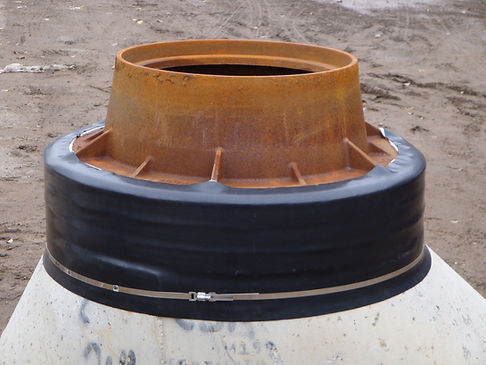
sanitary manhole chimney seals
One final step unique to sanitary manholes installations, reconstructions, or adjustments is keeping out the infiltration of ground and storm water from the area on the manhole, between the manhole top and bottom of the steel casting.
In this area, something typically referred to as a ‘chimney seal’ is installed in most sanitary manholes which acts as a long term seal from infiltration of water. There are both internal and external chimney seals. This is the final step of closing off the manhole from ground water infiltration.

Common internal chimney seal coverage area
There are many different types of chimney seal products but the most common ones are:
-paint on 2-part epoxy product (often polyurea product)
-wrap around heat shrinkable sheeting
-rubber sleeve/gasket type product with clamping bands
EPOXY INTERNAL CHIMNEY SEAL

The following is the common installation procedure for the epoxy product which is commonly done to the interior of the structure:
-the area of encapsulation is abraded with a minimum 70cfm sandblaster to promote bonding and adhesion
-the area is then blasted with clean air to remove dust and particles
-an acetone is wiped along the area to be encapsulated to rapidly dry any moisture from the area
-a primer is applied with a brush to the dry surface area of encapsulation to approximately 2” above and below the intended area of encapsulation
-the part 1 epoxy is applied followed by the 2nd part epoxy.
Note that sometimes 2 full kits are required depending on the size of the area to be encapsulated.
HEAT APPLIED EXTERNAL CHIMNEY SEAL
The following is the common installation of the wrap around heat shrinkable sheeting product which is commonly applied to the exterior of the area of encapsulation:
-the area of application is thoroughly cleaned of debris and particles and dried
-the rubber sheeting is then sized for the appropriate length needed including lap
-the initial sheeting is then applied by way of the stick-on side around the area of encapsulation
-then the initial sheet is heated with a propane torch to drive off moisture and temporarily set it in place from movement
-primer is then applied with a brush
-the final sheet is then wrapped around the primer and overlapped into position
-the sheeting is then heated from the bottom up circumferentially until the intended bond is achieved
-Any sheeting protruding up above the flange of the casting is then cut and heat applied for a final strong bond.
The assembly is then inspected and backfilled. Exterior wraps can be cumbersome if they require dedicated excavation and backfill to be completed.
HEAT APPLIED EXTERNAL CHIMNEY SEAL

The following is the common installation of the rubber sleeve/gasket type chimney seal product with clamping steel bands that is commonly installed on the interior of the area of encapsulation:
-The manhole(s) must be measured to assure the correct size rubber sleeve is ordered
-the area of application must be smooth and free of obstructions or protrusions or else the area must be made smooth in order for the product to seal correctly,
-the steel clamp bands are then installed into the band recesses and tightened into place with a proprietary tool.


